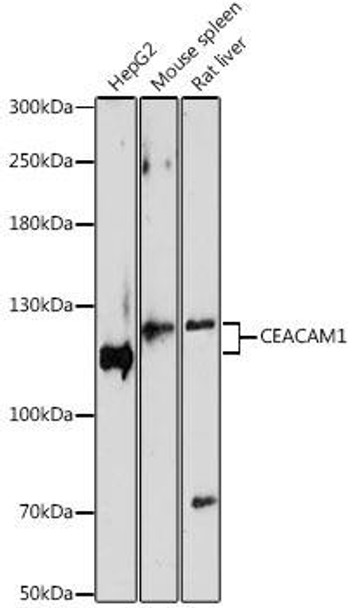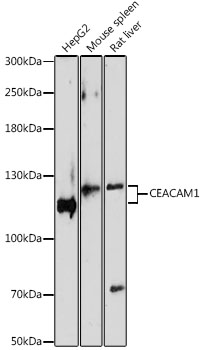Anti-CEACAM1 Antibody (CAB1702)
- SKU:
- CAB1702
- Product type:
- Antibody
- Reactivity:
- Human
- Mouse
- Rat
- Host Species:
- Rabbit
- Isotype:
- IgG
- Antibody Type:
- Polyclonal Antibody
- Research Area:
- Cell Biology
Frequently bought together:
Description
| Antibody Name: | Anti-CEACAM1 Antibody |
| Antibody SKU: | CAB1702 |
| Antibody Size: | 20uL, 50uL, 100uL |
| Application: | WB |
| Reactivity: | Human, Mouse, Rat |
| Host Species: | Rabbit |
| Immunogen: | Recombinant fusion protein containing a sequence corresponding to amino acids 300-430 of human CEACAM1 (NP_001192273.1). |
| Application: | WB |
| Recommended Dilution: | WB 1:500 - 1:2000 |
| Reactivity: | Human, Mouse, Rat |
| Positive Samples: | HepG2, Mouse spleen, Rat liver |
| Immunogen: | Recombinant fusion protein containing a sequence corresponding to amino acids 300-430 of human CEACAM1 (NP_001192273.1). |
| Purification Method: | Affinity purification |
| Storage Buffer: | Store at -20°C. Avoid freeze / thaw cycles. Buffer: PBS with 0.02% sodium azide, 50% glycerol, pH7.3. |
| Isotype: | IgG |
| Sequence: | HANN SVTG CNRT TVKT IIVT ELSP VVAK PQIK ASKT TVTG DKDS VNLT CSTN DTGI SIRW FFKN QSLP SSER MKLS QGNT TLSI NPVK REDA GTYW CEVF NPIS KNQS DPIM LNVN YNAL PQEN GLSP GAI |
| Gene ID: | 634 |
| Uniprot: | P13688 |
| Cellular Location: | Cell membrane, Secreted, Single-pass type I membrane protein |
| Calculated MW: | 27kDa/35-57kDa |
| Observed MW: | 120-130kDa |
| Synonyms: | CEACAM1, BGP, BGP1, BGPI |
| Background: | This gene encodes a member of the carcinoembryonic antigen (CEA) gene family, which belongs to the immunoglobulin superfamily. Two subgroups of the CEA family, the CEA cell adhesion molecules and the pregnancy-specific glycoproteins, are located within a 1.2 Mb cluster on the long arm of chromosome 19. Eleven pseudogenes of the CEA cell adhesion molecule subgroup are also found in the cluster. The encoded protein was originally described in bile ducts of liver as biliary glycoprotein. Subsequently, it was found to be a cell-cell adhesion molecule detected on leukocytes, epithelia, and endothelia. The encoded protein mediates cell adhesion via homophilic as well as heterophilic binding to other proteins of the subgroup. Multiple cellular activities have been attributed to the encoded protein, including roles in the differentiation and arrangement of tissue three-dimensional structure, angiogenesis, apoptosis, tumor suppression, metastasis, and the modulation of innate and adaptive immune responses. Multiple transcript variants encoding different isoforms have been reported, but the full-length nature of all variants has not been defined. |
| UniProt Protein Function: | CEACAM1: carcinoembryonic antigen-related cell adhesion molecule 1. A cell-cell adhesion molecule that directly associates with annexin II. Has tumor suppressor activity in prostate carcinoma. Belongs to the immunoglobulin superfamily and the CEA family. Abundantly expressed in epithelia, vessel endothelia, trophoblasts, platelets and neutrophilic granulocytes. Also present in many cell types of the immune system such as B cells, T cells, NK cells, macrophages and dendritic cells. Five alternatively spliced isoforms have been described. Two isoforms are type I membrane proteins, while three are secreted. |
| UniProt Protein Details: | Protein type:Membrane protein, integral; Motility/polarity/chemotaxis; Immunoglobulin superfamily; Cell adhesion Chromosomal Location of Human Ortholog: 19q13.2 Cellular Component: membrane; integral to plasma membrane; integral to membrane; plasma membrane Molecular Function:protein binding; protein homodimerization activity Biological Process: integrin-mediated signaling pathway; cell migration; angiogenesis; homophilic cell adhesion; blood coagulation; leukocyte migration |
| NCBI Summary: | This gene encodes a member of the carcinoembryonic antigen (CEA) gene family, which belongs to the immunoglobulin superfamily. Two subgroups of the CEA family, the CEA cell adhesion molecules and the pregnancy-specific glycoproteins, are located within a 1.2 Mb cluster on the long arm of chromosome 19. Eleven pseudogenes of the CEA cell adhesion molecule subgroup are also found in the cluster. The encoded protein was originally described in bile ducts of liver as biliary glycoprotein. Subsequently, it was found to be a cell-cell adhesion molecule detected on leukocytes, epithelia, and endothelia. The encoded protein mediates cell adhesion via homophilic as well as heterophilic binding to other proteins of the subgroup. Multiple cellular activities have been attributed to the encoded protein, including roles in the differentiation and arrangement of tissue three-dimensional structure, angiogenesis, apoptosis, tumor suppression, metastasis, and the modulation of innate and adaptive immune responses. Multiple transcript variants encoding different isoforms have been reported, but the full-length nature of all variants has not been defined. [provided by RefSeq, May 2010] |
| UniProt Code: | P13688 |
| NCBI GenInfo Identifier: | 399116 |
| NCBI Gene ID: | 634 |
| NCBI Accession: | P13688.2 |
| UniProt Related Accession: | P13688 |
| Molecular Weight: | |
| NCBI Full Name: | Carcinoembryonic antigen-related cell adhesion molecule 1 |
| NCBI Synonym Full Names: | CEA cell adhesion molecule 1 |
| NCBI Official Symbol: | CEACAM1 |
| NCBI Official Synonym Symbols: | BGP; BGP1; BGPI |
| NCBI Protein Information: | carcinoembryonic antigen-related cell adhesion molecule 1 |
| UniProt Protein Name: | Carcinoembryonic antigen-related cell adhesion molecule 1 |
| UniProt Synonym Protein Names: | Biliary glycoprotein 1; BGP-1; CD_antigen: CD66a |
| Protein Family: | CEACAM1-like protein |
| UniProt Gene Name: | CEACAM1 |
| UniProt Entry Name: | CEAM1_HUMAN |




